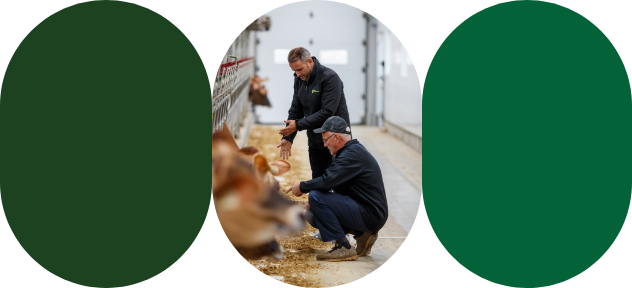Food for thought on breeding
Crossbred calves sell at such a high price that it can become sorely tempting to overproduce them. Here are some things to consider if you want to make the most profitable decisions for your dairy herd.
First and foremost, it’s important to know that US dairy production is in a unique situation right now:
Cattle numbers in the US are at their lowest in over 70 years.
From early 2022 to 2024, the total number of replacement dairy heifers in the US dropped by more than 10%, and the country’s heifer inventory has declined every year for the past seven years in a row. The domestic supply is at its lowest level in 20 years.
Cull cow sales have also hit an all-time low. As dairy farms struggle to find enough heifers to fill their stalls, they’re keeping their cows for longer.
“US milk production is dropping because we have far too many low-producing cows that we cannot replace,” says Steve Eicker, co-founder of Valley Agricultural Software, which produces the herd management software Dairy Comp 305. Average milk production per cow fell by 13 lb/head (5.9 kg) in April–June 2024 compared to the same period in 2023.
According to Steve Eicker, the current inventory situation will probably mean that dairy farms cannot maximize profits from the current rise in US milk prices, because they simply won’t have the animals to do so.
Given the situation, and with the high value of crossbred calves, dairy farmers need to ask themselves some serious questions:
How much does it cost to raise a heifer on my farm?
Am I raising enough heifers?
If I don’t raise the right amount, what are the consequences?
Are you raising enough heifers?
Too many farms don’t have enough calvings to meet quota and reap the benefits of voluntary selection. Others have the genetics, management and feed for their heifers to calve at 85% of mature weight, at 23––24 months.
There’s no one-size-fits-all solution, and breeding needs can vary drastically from farm to farm.
To find out if you’re raising enough, take a look at your heifer inventory and make your breeding decisions by asking yourself these three questions:
Is raising fewer heifers really more profitable?
What is the real cost of breeding?
How much extra income could I earn from breeding?
Is raising fewer heifers more profitable?
If your farm isn’t achieving the performance you want, or if you’re short on space or labour, the solution is probably to raise fewer heifers. On the other hand, this runs the risk of pulling you into a vicious cycle.
Why?
Because by raising fewer heifers, you end up having to buy cows when your milk supply drops. Statistics out of the US lead us to believe that the cow market will be expensive for the next few years, so you might be tempted to keep cows longer, even if they should really be culled due to udder health, reproduction, mobility, productivity, etc. And that’s when you get into the vicious cycle of culling when you have no other choice.
And when you’re stretched to your limits, sure, you save on breeding costs—but how much do you lose in revenue because you have a less productive herd?
Breeding and variable costs
According to 2023 figures from consulting groups, the cost of breeding is around $5,500 per heifer. Of course, the total cost is dependent on many factors, including:
The value of a heifer at birth
Employee and owner salaries
Fixed costs (building maintenance, rentals, equipment, etc.)
Amortization payments, interest on loans, etc.
So, is that truly representative of your farm?
For most farms, the variable costs of raising a dairy heifer will be around $3,000, excluding the value of the heifer itself. Half of that is for forage, which isn’t a fully out-of-pocket expense and varies greatly in terms of cost from one farm to the next.
If a crossbred veal calf is worth $1,000 at birth, you might be thinking, “If I can sell a calf for $1,000 at birth and save $3,000 in variable costs to raise it, that’s $4,000 that I can use to buy a cow!”
But you have to find one first. In a market where cows are scarce and expensive, the situation could become as risky as it is for our neighbours south of the border, who are now in a vicious cycle of culling only when they have no other choice.
On the other hand, if you decide to raise more heifers because you’re good at it and have the infrastructure, your labour and fixed costs will probably stay the same. In that case, your average cost of raising a heifer will be much lower.
The reverse is true if you raise fewer heifers: the average cost per head goes up.
Let’s take an example:
You have a 100-cow farm with 65 heifers in inventory, and you have barn space to raise 10 more. That puts you at 75 heifers.
Will that affect your payroll? Will it increase your fixed costs? I’m betting the answer is no.
Could you earn more by raising more heifers?
If you go from 65 to 75 heifers in inventory, that’s five more calvings a year. That can help you:
Make quota and generate income
Be less dependent on the rising market price of cows
Sell cows for production
Improve herd performance through voluntary disposals
You’ll end up with more calves to sell and more cull cow revenue, which will largely cover the variable costs of rearing those extra heifers.
What’s your ideal heifer inventory?
We’re at a very particular point in history. You have important decisions to make that will impact the farm economy in the coming years..
Now more than ever, it’s crucial to take a step back and try to anticipate what’s going to happen to supply and demand in the short and medium term.
Consider your constraints, options, and most importantly, goals, and remember that it all starts at insemination. Try to anticipate what’s going to be best for you. Every farm is going to have its own reasons to raise more or fewer heifers.
For help answering these questions and determining the best strategy for you, contact your agri-advisor. Based on your cow inventory, production, culling rate, heifer calving age, and the different conception rates you expect to see, they can calculate the number of calvings you need every month to replace your cows as needed. And they’ll build in the safety margin you decide you want.
Think about it!



